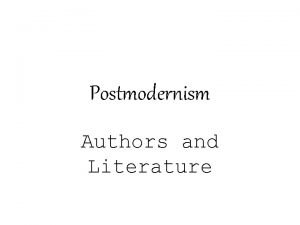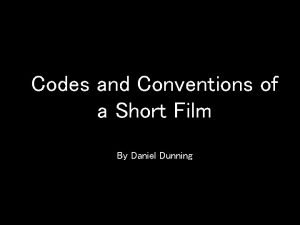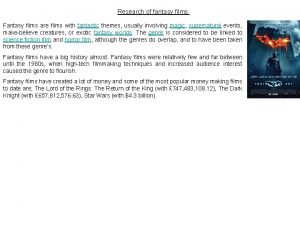1 Postmodernist films upsets the mainstream conventions of





- Slides: 5

1. Postmodernist films upsets the mainstream conventions of narrative structure and characterisation and destroys the audience’s suspension of belief

• 2. They don’t pretend to be wholly works, and often draw attention to the fact they are in fact fictitious. For instance, characters might stop and talk directly to the audience. They often re-arrange or disrupt strict linear narratives, instead using circular narratives and open ended closures. They often involve characters that feel disconnected or alienated from their environment and distrust authorities.

• 3. Genres of Postmodern film: • Pastiche: Self referential, tongue-in-cheek, rehashes of classic pop culture. • Flattening of Affect: Technology, violence, drugs, and the media lead to detached, emotionless, unauthentic lives. • Hyper reality: Technologically created realities are often more authentic or desirable than the real world.

• Time Bending: Time travel provides another way to shape reality and play “what if” games with society. • Altered states: Drugs, mental illness and technology provide a dark, often psychedelic, gateways to new internal realities. • More Human than Human: Artificial intelligence, robotics and cybernetics seek to enhance, or replace, humanity.

Analysis of a flattening affect in the film “fight club”. A ticking-time-bomb insomniac and a slippery soap salesman channel primal male aggression into a shocking new form of therapy. Their concept catches on, with underground "fight clubs" forming in every town, until an eccentric gets in the way and ignites an out-of-control spiral toward oblivion. The main protagonist’s journey from a depressed insomniac to, to an unhinged violent psychopath, Is according to the postmodernism theory, the characterization of a protagonist who is disconnected from wider society, this is a key feature of a postmodern film. In Fight Club the movie uses a narrator through out the film who is one of the main protagonist this is another postmodern concept. This type of cinematography disrupts the linear sequence of the narrative and instead creates a circular narrative in which parts of the film are cliff hangers where the audience does not know what’s happening next mirroring the actions of the main protagonist. Broadcast media bulletins are used to create suspense and tension. A dark color scheme connotes to the audience that this film is going to be violent and scary. This film is a classic example of the postmodernist theory. • (190 words… you do an 800 word one!)









